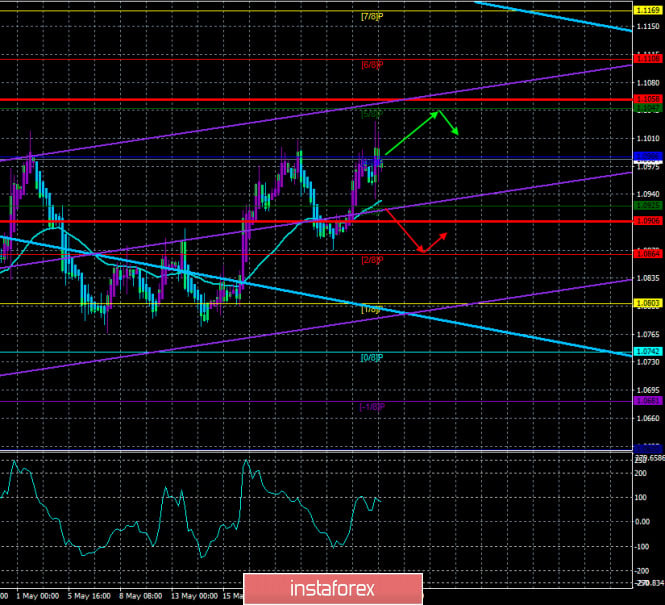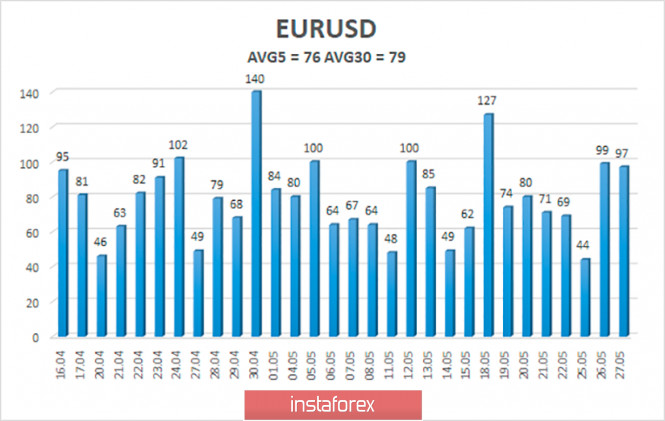4-hour timeframe

Technical details:
Higher linear regression channel: direction - downward.
Lower linear regression channel: direction - upward.
Moving average (20; smoothed) - upward.
CCI: 81.5859
The EUR/USD currency pair spent the third trading day of the week in a new round of upward movement, which was quite unexpected. However, at the end of the day, we still cannot conclude that the pair has crossed the upper limit of the side channel of 1.0750-1.1000. There was a false breakout, but by the end of Wednesday, the pair's quotes fell back from the highs of the day. Thus, the option with a downward movement to the level of 1.0750 still retains its prospects. At the same time, we do not recommend completely excluding the option of forming a new upward trend. If a confident and unambiguous overcoming of the area of 1.0990-1.1008 happens, then the bulls can continue to develop their success.
In the final article over the past day, we said that traders once again ignored a rather important event, namely the speech of ECB President Christine Lagarde, during which she announced a stronger contraction of the European economy by the end of 2020 than originally planned. However, this is not all the information available to traders on Wednesday. It became known that the European Commission is preparing a new plan for the economic recovery of about 750 billion euros. This was stated on May 27 by European Commission member Paolo Gentiloni. Of these 750 billion euros, it is proposed to distribute about 500 billion in grants and another 250 billion in loans. This plan will be officially presented by the head of the European Commission, Ursula von der Leyen, in the near future. Earlier, French President Emmanuel Macron and German Chancellor Angela Merkel proposed to create a recovery fund for 500 billion euros, the funds from which will be distributed in the form of grants, that is, on a non-refundable basis. And this plan was immediately criticized, since Austria, Denmark, the Netherlands, Sweden, and Finland do not consider it right to give money away for free. We also remind that no plan can be adopted without the approval of all 27 EU member states. Thus, the main issues that need to be resolved in both of these plans are mainly in the form of assistance. The most economical and strict countries believe that it is necessary to provide assistance in the form of loans. The countries most affected and in need of assistance are willing to receive grants. In addition, there is the so-called "Northern plan", which was presented by Austria, Denmark, the Netherlands, and Sweden. These countries believe that aid should be allocated exclusively on the terms of concessional lending, otherwise, the least disciplined economies will regularly use the financing of those countries that are economically stronger and more economical. At the same time, even soft loans, according to the "northerners", should be provided only on the condition of large-scale reforms and strict compliance with budgets. The authors of the "Northern plan" are unequivocally opposed to any increase in the EU budget.
Certain details of the future financial assistance plan, if approved, have also been released. For example, Italy and Spain will receive about 40% of 750 billion euros. Approximately half on the terms of concessional lending and on gratuitous terms. According to some experts, grants will also be distributed according to the priority of the "green economy" - the EU's plan to reduce carbon emissions to zero by 2050. Thus, those sectors of the economy, in other words, enterprises that try to comply with EU standards, will have a better chance of receiving assistance. It is also reported that the European Commission has identified three main priority areas for economic recovery: updating the residential and industrial sector of buildings; the use of energy-saving technologies in it; financing alternative energy and hydrogen fuel projects; the development of "clean" transport and electrified railways.
However, in the case of the new plan of the European Commission, the problems are still the same. The main question, of course, is where to get these 750 billion euros? Recall that not only the UK will suffer from the "break" with the EU. The alliance will also lose about 13 billion annually from the "break" with the UK. Given the fact that the pandemic has had a negative impact on all EU countries, it is unlikely that these funds can be raised by increasing contributions. Thus, again, they can only be obtained by loans or by raising certain taxes. However, even taking into account the possible tax increase, experts believe that it will not be possible to collect 750 billion euros. And some members of the block also oppose the use of borrowed funds for the formation of the fund. Thus, this plan can also be buried on the sidelines of the European Commission.
On the fourth trading day of the week, the European Union again does not plan any important macroeconomic publications. However, there will be something to pay attention to in Germany and the United States. The consumer price index for May will become known in the locomotive of the European economy, which threatens to slow down even more and reach 0.6% y / y according to preliminary values. In the US, an important report on orders for durable goods will be released on this day. According to expert forecasts, the overall figure will decline after March -14.4% by another 19%. The index of orders for capital goods excluding defense and aviation may lose 10%, and orders for goods excluding transport may lose about 14% in April. Thus, this report may cause a drop in demand for the US dollar during tomorrow's US trading session. However, we should also note the next report on applications for unemployment benefits overseas, which in recent months has become almost the number 1 report in the United States. According to the new data, the number of primary applications for benefits in the week up to May 22 will be 2.1 million, and the total number of secondary applications for benefits in the week up to May 15 will be 25.75 million. Many experts and traders believe that the second indicator most accurately reflects the current unemployment rate in the country. And as we can see, its growth rate is slowing down, the increase in secondary applications for the week may be only 700,000. Also scheduled for this day are reports on personal consumption expenditures and pending home sales transactions. However, these data did not cause any reaction even in normal and quiet times. Now they will be ignored with a 100% probability.

The average volatility of the euro/dollar currency pair as of May 28 is 76 points. Thus, the value of the indicator is characterized at this time as "average". Today, we expect the pair to move between the levels of 1.0906 and 1.1058. The reversal of the Heiken Ashi indicator downwards signals a very likely resumption of the downward movement to the lower border of the side channel of 1.0750-1.1000.
Nearest support levels:
S1 – 1.0925
S2 – 1.0864
S3 – 1.0803
Nearest resistance levels:
R1 – 1.0986
R2 – 1.1047
R3 – 1.1108
Trading recommendations:
The EUR/USD pair made another round of upward movement within the side channel and again stopped near its upper border. Formally, buy orders are currently relevant since the price is located above the moving average. However, we do not recommend opening buy positions until the area of 1.0986-1.1008 is successfully overcome. It is recommended to return to selling the pair if the price is re-anchored below the moving average line with the goals of 1.0864 and 1.0803.
The material has been provided by InstaForex Company - www.instaforex.com